 Gravity, Turbulence and Magnetic field in Planetary rings, circumstellar disks, star formation and galaxies
Gravity, Turbulence and Magnetic field in Planetary rings, circumstellar disks, star formation and galaxies





In the last chapter I have explained the creation of the universe and the phenomena observed in the cosmos without discussing much about the role of the gravitational force.The role played by gravity around the planetary system around the sun has been successfully tested. No one can doubt today the fact that the gravitational forces are central in deciding the orbits and the periods of revolutions of the planets. The data from several spacecrafts, which have been sent to study the different planets and their moons have shown the near infallible nature of the gravitational theory once proposed by Newton and later modified by a relativistic correction.
Until recently this clockwork of the mechanized planetary system with large number of moons flanking the outer planets, seemed to be a perfect manifestation of cosmic order destined by gravity. However, the newer data from spacecrafts sent to study the outer planets and their rings have impelled us to reevaluate our understanding about the role that gravity plays in the formation of the structures. Simulations show that the interactions of the outer planets cause chaotic motions. The ejections of asteroids out of the asteroid belts, as well as the occasional trace passing of the comets from the Kuiper belt beyond Neptune inside the inner solar system are believed to be the results of the chaotic dynamics. However, the chaos raging in the outer solar system have little effect on the stability of planetary motions, especially those which lie in the inner region. It may have caused migrations of the outer planets from their present orbits.
In this stable planetary sphere the most striking examples of chaos are seen in the planetary rings and in motions of a few moonlets, which are embedded inside the rings. The best example is the rings of Saturn and its two moonlets called Prometheus and Pandora which rotate outside the main rings. These small moonlets show chaotic behavior, which apparently seems to defy the law of gravity. Prometheus moves just inside the F-ring of Saturn and Pandora orbits just outside. They are known as the shepherd moons because it is believed that the gravitational pull from these moonlets keep the dusts from escaping the very thin F-ring, which circumscribe the main A- and B-rings.
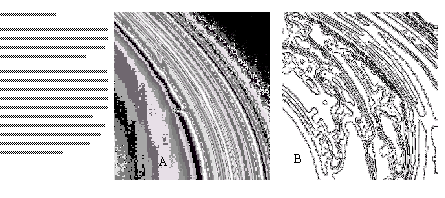
Not only the orbital paths of Prometheus and Pandora show unpredictable chaotic courses, the strands in the rings, which they are supposed to keep in place appear intricately braided and knotted.
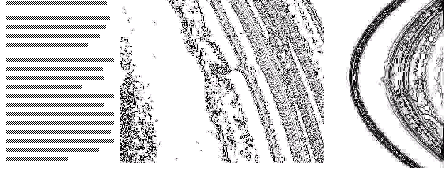
When one sees the complex nature of the structures which entangle the rings, especially the radially emerging spokes, one does not feel convinced about the argument that the gravitational forces of the planet, and the moonlets could be solely responsible for creating such structures. The radially moving spokes, observed in the B-ring of Saturn by the Voyager 1 and Voyager 2 spacecrafts, are the most notorious examples which hint at some additional dynamics that might be at play behind the formation of the rings. The B-ring spokes rotate at the same speed as the rotation of the Saturn's magnetic field, indicating a close relationship between the dynamics of the spokes and the magnetic field of the planet. The magnetic levitation of the charged dusts from the ring plane, which get trapped in the magnetic field and rotate with it, can provide an explanation for understanding the spoke phenomena.
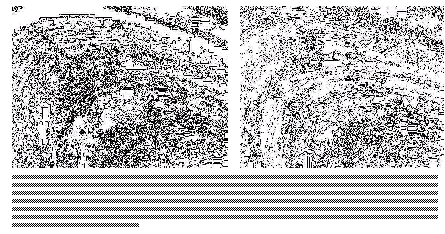
There exist several indications that the magnetic fields of the planets may play important roles in the formation of the ring structures. Under the apparently undisturbed rings, as seen in the latest mission to study the rings of Saturn with the help of the instruments on board the Cassini spacecraft, one discovers fractal structures. The innumerable ringlets, which are placed successively as rings inside rings, hide a finer view of the more complex structure. This illusion is caused due to the angle of viewing, and the nature of the scattering of light by the dust. The size of the dust particles and the way the light is reflected from the dust surfaces, which varies with the angle of the sunlight falling on the ring plane, can reveal, about or hide the fractal structures, which penetrate the entire ring system.
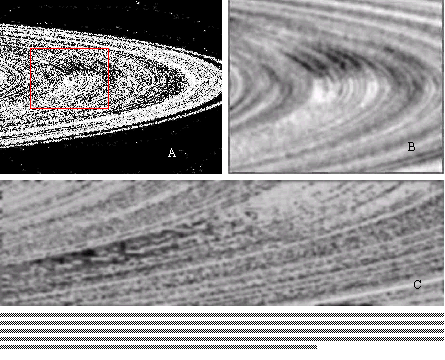
The existence of radially protruded spokes appear to be a generic phenomenon as regards the formation of rings around the planets. It can also be seen in the main ring of Jupiter. None of the ringlets, which one sees in the photographic images, are even threads lying cleanly separated at different distances from the planet, while the dust move in Keplerian orbits along these ringlets. The dynamics appear to be much more complex. Ripples move along the ringlets, which may break in places and undergo merging with other immediately close lying ringlets, as the results of the fluctuations moving along the strands. Therefore, instead of being tied to prescribed Keplerian orbits, the dust particles may migrate from one ring to the other, while maintaining a fractal pattern, which remains stable for longer time. The charging of the dust caused by the solar activities may ensure variations of interaction of the dust particles with the magnetic field of the planet and thus cause time varying fluctuations of the particle migrations.
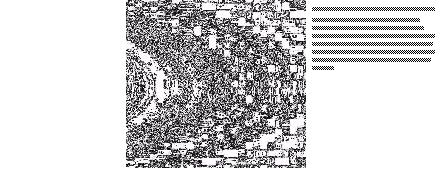
The ejections of dust streams observed by the spacecrafts from the equatorial plane of Saturn and Jupiter indicate that dusts migrate outward from the planetary rings as the results of the magnetic interaction of the planet with the ring material. Together with ejections away from the rings, there also occur movements of dusts towards the planet. Some charged particles trapped by the magnetosphere may move from the equatorial region to the polar region. These dusts may swirl upward and end up over the poles.
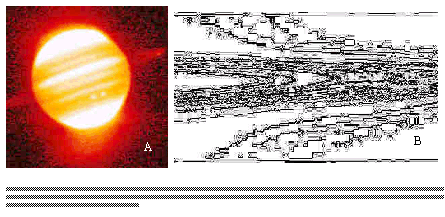
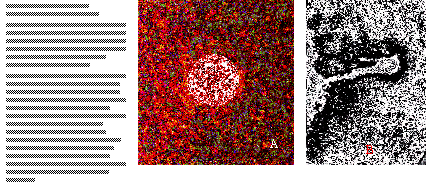
The movements of dusts indicate that the dust dynamics of the rings along the equatorial plane, are closely connected with the polar activities, like the formation of the auroras. These polar and equatorial activities are mainly caused by the magnetospheres present around the planets. The auroral activities are also intimately connected with the solar flares and the plasma winds blowing from the sun. Therefore one feels inclined to believe that the fractal structures, one observes in the rings, could be the results of the interactions of the solar wind, the equatorial plasma and the auroral activities. While gravity may act as the pulling force trying to put the dusts in ringlets following Kepelrian motions, the other actors in the planetary dynamics seem to generate chaos around the planets by causing migrations of the dusts from the Keplerian orbits.
Though the local magnetic fields of the planets play an important role in the formation of structures around the planets, the orbital motions of the planets are decided mainly by the solar gravity. Though the solar magnetic field may affect the dynamics of the interplanetary dust, there is nothing appreciably measurable which can put into question the role of gravitational force in deciding the orbital paths of the planets. At least, this is what we have believed until recently. A new situation has risen with the observation of the slowing down of the spacecrafts as they move through the outer realms of the solar system. Especially the observations made with regard to the motions of the Pioneer 10 and Pioneer 11 spacecrafts, sent in the opposite directions of the solar system, have aroused the spectre of the existence of an unknown force, which could be slowing down the spacecrafts by pulling them a little harder towards the direction of the sun. The peculiarity of this extra force appears only after the spacecrafts have entered a realm beyond Saturn. The pull remains constant thereafter. There are many speculations about the nature of this force. Since it appears only in the outer realm of the solar system, one may suspect the presence of unseen material in the outer boundaries of the system, which could be bringing about the phenomenon. It has been speculated that Kuiper Belt material could be much more than what one has estimated from the observations of the dusts seen in the outer realm. The pull could be caused by the extra mass of the shells which may circumscribe the outer parts of the solar system. The arguments fall into trouble when one sees no effect of this extra mass on the planets orbiting beyond, or within these shells.
In spite of this small glitch in our understanding of the anomalous motions of the spacecrafts by the help of gravity, the celestial mechanics, where the gravitational force is the sole dominating player, seems to reign supreme. The spacecrafts which have only deviated by a few hundred thousand of kilometers along their journeys through space for more than three decades, while crossing billions of kilometers, seem not to be able to put in doubt the success which the gravitational theories have enjoyed.
In spite of the local effects of the magnetic fields around the planets, and the chaotic paths of a few moonlets, or the asteroids, or the objects emerging from the cometary belts, the solar system is truly a place where gravity works pretty well. Based on this success in understanding a system which spans less than a light-day in size, we have built our understanding of the entire cosmos which spans over billions of light-years. We have assumed that gravity is the sole actor in the formation of the cosmos, and based on this view we have built our creation theory of the universe. By solving Einstein's equations of gravity we have come to the conclusion that universe, driven solely by gravity, has started its expansion from a singular point, where the entire mass of the cosmos were once concentrated.
As I have said before, I try to argue in this book that this is only a particular view. There could be other ways to understand the formation of structures in the universe. Gravity might the sole arbitrator in deciding the planetary orbits in the solar system. However, it does not necessarily mean that it is the sole force in deciding the dynamics of the universe. The present creation theory relates that all other forces in nature emerged as consequences of the cooling of a primordial radiation ball of nearly billion trillion trillion degree. Within a trillionth of a second after the explosion took place all different forces of nature separated from a phase when all forces of nature were of equal strengths. Within a few minutes the nuclear force put together all the atomic nuclei present in the universe. However, it took 300 000 years before the universe was cool enough for the atomic nuclei to be able to pull the roaming electrons into orbits by using electromagnetic force and thus form atoms. After that, the structures, we observe in the universe, emerged from a cloud of gases made mostly of hydrogen.
The scenario of formation involves gravitational instabilities in the gas clouds, which cause fragmentation of the clouds, which further fragment into smaller and smaller chunks. However, as I have told earlier, this gravitation based creation theory faces extreme difficulties in explaining the formation of the structures in the universe. First, an unknown matter component, which has not been observed and called dark matter, play a crucial role in such a theory. Moreover, the universe, as observed, appears to prefer merging of smaller structures into bigger clumps than undergoing fragmentation process. The problem related to the structure formation has brought an immense challenge to the gravitation based creation theory.
As said, the creation of structures arising from pure gravitational instabilities is only a particular scientific view promoted by people, who have extended the success of understanding planetary motions by using gravitation model to the realm of the entire cosmos. The view presented in this book is different from this standard wisdom. I have argued for a universe, which did not start at a point, while heralding in the existence of time. The universe, I have proposed, has no beginning or end, and the time itself needs to be conceived in a totally different manner than what we have got used to. I have related these stories in other places of this book. Here, in this chapter, my purpose is to elucidate how the other forces of nature may have helped in sculpting the structures.
According to the new theory, the main foundation of structure formation lies in the existence of turbulence. The entire universe could be an embodiment of matter in a turbulent eddy, which self generates structures within itself, by dismantling structures in one place and reassembling those decay products in other places. According to this view the universe is an ever fluctuating arena of death and birth driven mainly by the eddy dynamics. The way the motions fluctuate and the matter migrates throughout the space, and the manner by which these fluctuations and transport bring forth knotty structures, which appear as cosmic objects at different scales, as well as the processes by which the universe bring annihilation to planets, stars, galaxies, clusters, superclusters etc. remain eternally and everywhere the same, independent of the scales at which one may observe the cosmos.
Instead of holding on to the view that all came forth by the magic intervention of the gravitational force out of a state, when physical laws and time did not exist, and where it is meaningless to ask the question "What was before that time?", the new theory promotes the idea that all existed, as it is observed now, for ever. The universe has existed in its turbulent state for ever because it is the most perfect state of order, which lies hidden behind chaos. This is a state, critically balanced between equilibrium and non-equilibrium, which can bring growth and decay into a perfect balance. The balance is maintained by the process of self-regularization, which brings back the outgoing and decaying material as inflowing and life giving matter towards the source from where it once emerged. In the universe all what flows out returns so that the universe may rise again and again from its death and annihilation everywhere.
In this view the universe is a whirlpool of gas and dust where knotty clumps form and decay as cosmic structures appearing as superclusters of galaxies, clusters of galaxies, galaxies, stars and planets, for example as seen at different scales. Though all forces of nature are present everywhere at all times, the way they participate in the formations of structures may not be the same at every scales and in all phases of evolutionary developments of the structures. In the surrounding where storms and turbulence generate the maximum effects over the gases and dusts, the gravitational pull of the dusts among themselves may have little role to play. The gravitational effects will only appear when the dusts have been able to condense into appreciable sizes which can then compete with the forces generated by the kinematic forcing of the gas clouds. Therefore, in a world where the eddy storms supply the main energies to the local scales, where dusts may precipitate, the gravitation will not play a big role, or a very negligible role. The storms will tear apart all that the gravitation will try to pull together.
Moreover, as I have explained in the chapter dealing with vortex dynamics, turbulence is not any homogeneous and isotropic soup of dust and gas. It generates an entanglement of filaments and knots of different densities while creating an inhomogeneous fractal pattern. The storms and turbulence create collisions and give birth to ionized zones of different strengths, where the magnetic forces compete with turbulence and gravity. Where the magnetic forces are stronger, it may override the gravitational pull and carry material along the magnetic lines of force, as one sees in the cases of the planetary rings, for example. For the gravity to dominate over the other factors, first the bodies, formed from the condensations of the dusts, must be appreciably large, which can then pull the dust and gas material to themselves, while neutralizing other forces to a great extent. Thus formations of structures in the universe are driven by several competing factors, among which the turbulence kinetic forcing, the magnetic forces and gravity, are very central.
In the rest of this chapter I shall discuss the ways these forces may participate in generating the structures in the planetary scales, as well as the stellar and the galactic sizes. I have built my understanding of these questions by studying different simulations, which have been done by different scientific groups, and through my own analysis. Not only the subject is extremely complex, the simulations are very difficult to perform, and the analysis are highly dependent on the assumptions one may make at the outset. So it is not an easy path to arrive at any definite unambiguous conclusion by putting together the basic equations of hydrodynamic, electromagnetism and gravity together and solving them as non-linear coupled system. In spite of these enormous difficulties, I believe, such studies may give some indicative hints. However, I shall not present the standard view. Instead, I shall present the issues from the point of view of my new theory. My motivation is to look for elements that may help to put the puzzle together where turbulence rage, the magnetic forces compete, and the gravity descends to play an appreciable role only at the level of very small scales, where structures have gained the densities as observed in the planets of the solar system (or higher).
The roles, which the turbulence and the magnetic forces may play in the formation of cosmic objects, have come into focus only recently. It started with the problems of explaining the rate of star formations in galaxies. The magnetic forces and the turbulence have also received much attention lately as regards the studies of the formation of the circumstellar disks, and the planets out of such disk material. The effects of magnetic field and turbulence in the formations of galaxies have also becomes a new frontier. I shall briefly discuss these issues below.
The idea of the formation of stars by the gravitational attraction has dominated the theory of star formation until recently. The majority of star formations are seen to occur in dense molecular clouds of hydrogen. The conventional understanding until now has been that once the cloud clumps become gravitationally unstable, the collapse sets in, which increases the density of the central core forming proto-stellar systems. The cores of these protostellar systems then collapse further due to gravity, while the cores accrete matter from the surrounding and grow.
However, the observations of the star formation in the molecular clouds of the galaxies show that the scenario of the gravitational collapse is not satisfactory in explaining the number of stars which one observes in the galaxies. For example, the disk of the Milky Way galaxy contains molecular gas of more than 10 9 solar masses distributed in typical cloud sizes of 106 solar masses. If the star formation occurs mainly through gravitational collapse these dense clouds should produce stars at a rate of hundred times more than what are actually seen.
To explain this observed slow rate of formation of the stars, a class of theory based on the idea of threading of the magnetic field through the molecular clouds have been proposed. Magnetostatic pressure, or magnetohydrodynamic (MHD) waves are suggested, which would counteract the gravitational force, and support the molecular clouds from collapsing and forming stars. However, the observation of the magnetic field in the Milky Way galaxy suggests that the magnetic field in the galaxy is not strong enough to prevent the collapse of the molecular clouds due to the gravitational attraction to the extent that the observed star formation rate can be explained. To deal with this situation, recently, the idea of turbulence has come to the forefront. The supersonic turbulence observed to be present in the molecular clouds are believed to inhibit the collapse. The kinetic energies of the turbulent clouds dominate over the gravitational potential and trigger the formation of the cores.
The supersonic turbulence generate filaments of different densities in the gas clouds. In these filaments knots form. In these knotty structures the stars take their births. Turbulence generates knots of different strengths and sizes, and thus act as the moderator for the creation of stars of different masses and sizes. Moreover, the turbulent motions can produce clumpiness much more quickly than the scenario in which gas clouds collapse as results of gravitational instabilities. This rapid formation are seen in star clusters, where the turbulent eddies break into smaller eddies. The recent simulations and observations indicate that turbulence models are much better models in accounting for the generation of different low and high mass stars in the same cloud regions.
Turbulences create spiral pattern, where two spiral arms are attached to the core and wound around it. Initially the gas content of these arms could be much larger than the mass assembled at the core. This phase is called the pre-protostellar phase. The crucial element, which decides how the star will evolve after the spiral structure has been formed, depends on the nature of the this initial core. On has also measured magnetic fields in the pre-protostellar clouds, which indicate the twisting of the fields due to the presence of turbulent motions. These magnetic fields play a crucial role in setting the stage for the development of the core to a protostar.

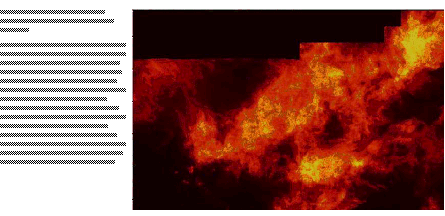
In the molecular clouds the pre-protostellar and protostellar objects are found in the darker realms which form in the inner region of the cloud. Away from the core one finds stars of more evolved nature. The characteristic of the star forming molecular clouds are that they possess supersonic turbulence. These turbulences are accompanied by jets emerging from the core and plying through the dense gaseous medium. As the jets slam on the surrounding material they create shocks and press the gas clouds against the larger cloud environment, in which the smaller molecular clouds are embedded. The compression and shock also generate swirling eddies and filaments, which move in elongated structures like serpents moving in different direction. The high vorticity areas, where the eddies trap the gaseous chunks from escaping the region, set the stage for the star formation.
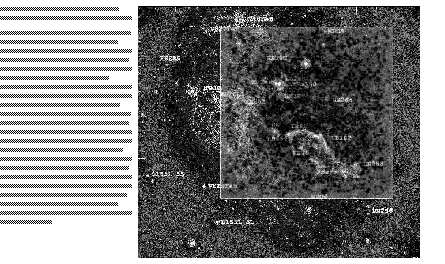
The star formation proceeds from the stage of the formation of a spiral whorl at the core of the swirling eddies, where gases may carry magnetic fields. After that, the magnetic fields become one of the main players in shaping the core, and generating the first seeds from where the stars would start to evolve. To begin with, the evolution of the core may be determined by the dynamics of turbulence and the magnetic field. Magnetic torques, generated by the spiral arms, will set a magnetic accretion process while pushing the gases towards the core. The existence of a spinning core surrounded by a whirling spiral arms of gases would generate more and more magnetic accretion of gas to the star, and the spiral arms would wound into a disk. The magnetic field will cause the disc material to move towards the polar region of the stars, the discs may gradually erode due to the increasing intensities of the stellar winds emerging from the stars as they start burning vigorously. The stellar winds may eventually clear up the disc material. The formation of the stars are seen to occur with the emergence of jets moving in opposite directions from the poles. These existence of the jets can only be understood as being caused by the magnetic fields present in the clouds.
One of the most studied molecular clouds is the Taurus cloud, where one can observe how the very young stars are being born. Especially the region known as L1551 is a very efficient place of star formation, and has been used as an ideal laboratory for studying the birth of the very young systems. This region lies south of the Taurus cloud core.
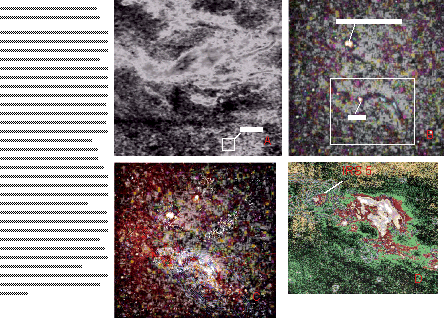
This scenario of star formation does not fit with the conventional view. Instead of the gravitational condensation of the core in a cloud, compressed by shocks created by supernova explosions, which then gravitationally accrete from the surrounding gases and grow, the turbulence and magnetic fields are the most central players in this story. The most successful models of T-tauri stars (small mass stars like sun) accreting from the surrounding discs involve very high magnetic fields of the order of kilo Gauss. Such strong magnetic fields have already been observed in the early stages of star formation.
Though the central roles of magnetic field and turbulence are recognized, the way the stars form is not yet understood. The theoretical understanding at the present moment can be described as follows: Magnetic fields in the rotating clouds form an hour glass shaped field that is pinched inward by the forming disk. The accreting central proto-star, which becomes fully convective after its formation, supports a co-rotating roughly dipolar magnetic field which may extend to 5 to 10 stellar radii. Inside the radius, where the Keplerian rotation is the same as the rotation of the star, the magnetic ffield dominates all pressures, and rotates as a rigid body anchored to the star. Matter is picked up from the disk, forced to move along magnetically dominated columns to high latitudes towards the poles, where it is accreted onto the star. In this scenario, the material outside the Keplerian orbit co-rotating with the star, a magneto-centrifugally driven wind fuel outward ejections. The magnetic forces on the open field lines at a distance 0.1 to 10 AU from the star become responsible for collimating the wind into jets.
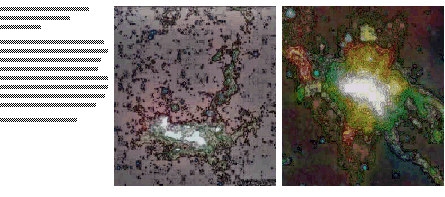
My own understanding of the star formation involves interactions of vortices at the centre which have come forth as results of the turbulence. This central vorticity area is flat and may take the shape of an elongated disk, where he magnetic fields get entangled in a complex manner. The magnetic fields operating in turbulent vortices cause ejections along the elongated axis, while at the same time driving the portions of the disk material to move perpendicular to the disk plane. These north and southward moving ejections generate magnetic loops, as seen in the solar corona. The breakdown of the loops cause the high speed acceleration of material from the core. Such high speed motions of the ionized gases along the magnetic field lines may cause x-ray emissions. Under the influence of the magnetic fields the central vortices may undergo shape transformations. As the poloidal fields grow, the disc may disintegrate into several stellar clumps, while giving birth to multiple stars at the centre, which remains flanked by bubbles ejected on the opposite sides.The growth of a single star will proceed in a similar manner. As the results of magnetic accretion when the stellar cores will turn denser, the gravitational attraction, due to the mass present in the star, will start playing a role in the evolution of the star formation. However, only when a solid core has formed in the star the gravitation will be an important player. As long as the star formation involves mostly gases and plasma, the dynamics will be driven mostly by turbulence and magnetic fields.
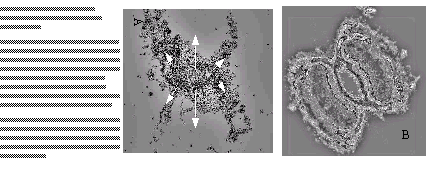
It is well known that formation of single isolated stars are very rare. The stars are mostly seen to form in groups. The formations of large groups, and small groups both seem to proceed in the similar manner described. The multiple stars arise from the fragmentation of the central structure, caused by the interactions of the vortices undergoing stresses generated by the gradually intensifying magnetic fields. After the core splits into several separate single stars, and the turbulent motions churning the clouds at the centre have subsided in the surrounding environment, the gravitational forces of the new born stars may act on each other, and thus decide the future courses of their motions. Some may be flung away from the core, some may end up as gravitationally bound multiple systems, like the innumerable binary stars, which one often observes.
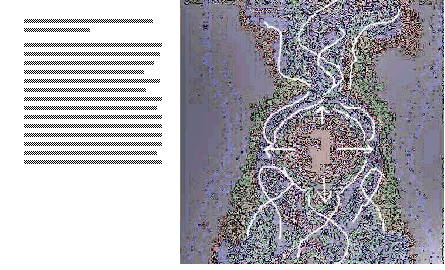
The stars, as they developed from a flat structure to a spherical one, form more and more collimated jets emerging from the polar regions. These jets become more and more pronounced while the bubbles, which start as wide angled ejections in the form of cones, gradually shrink towards the polar axis and at the end dwindle and disperse as hot gaseous nebula in space. The jets and hydrogen burning in the stars create enough heat and radiation pressure to clean up the surrounding.
According to the presently popular theories the planets form from the material, which are still left over around the star after this clean up process has occurred. Before I describe my view about the planet formation I shall first explain the evolutionary process by which the flat disk-like shape may turn spherical. Later I shall argue that planet formation may have similarity with this process.
According to my view the turbulent vortices generate magnetic loops in different scales. Like in the sunspots the vortices act as mouths joining the magnetic loops. The loops which are generated closer to the centre can trap the hot gases. As the star rotates these trapped hot gases swirl around the axis and spread the material as sprinkler around the star and thus give birth to the stellar surfaces. The larger loops form the bubbles around the star. With the evolution of the stars the bubble disappear and the magnetic loops closer to the centre form an entangled sphere of gaseous material, where gravity may not have much role to play.
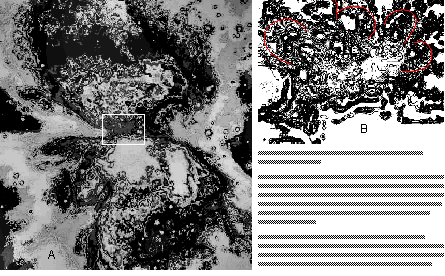
The entanglement of the loops forming the stellar surface seem to follow a specific pattern. The ejected gases, moving from the equatorial plane towards each poles, create braided structures when they meet. The similar braided pattern pile up over each other, as shells over shells, where larger shells envelop similar smaller shells. I have discussed this fractal stacking up of shells in an earlier chapter. This process of fractal build up continues down to the outer layers of the stellar surfaces. In other words, the bubbles continue to embossom smaller bubbles on each side of the poles, until reaching the centre, where the bubbles on the two sides merge to form the shape of the star. The structures of well evolved stars, where the jets and winds have cleared away the surrounding space, and the stars have taken near spherical shapes, will involve jets moving in the opposite direction from the centre along the equatorial plane. These jets will bend towards the poles and carry gases from the equators to the poles. This process will generate fractal shells embedded inside each other. When the gases and plasma meet at the polar regions they form knotted and braided structures, which act as magnetic "corcks" holding the mouths, through which the jets have been erupting in earlier stages of formation. They keep the material against escaping the core region. Reaching the pole the gases and plasmas are forced to sink inward from where they start their journey towards the stellar surface as ejections along the equator once again. Recent observations have confirmed this rising of gases from the equator to the poles moving along the surfaces, and then sinking of gases from the poles towards the equator in the deep interior of the sun. This circulation process generates two bow-shaped structures as two lobes which flank the stellar core. These bow-shaped structures are tied together at the top and bottom by the knots, which form when the masses moving towards the poles meet.
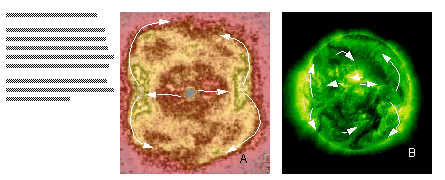
The stellar surfaces thus formed contain large sized vortices generated by the intertwisted and braided structures. The most intense vortices should occur at the mouths from where the gases rise from the low altitude to high altitude regions, i.e. in the middle of the bow-shaped structures near the equator. Other large vortices will form in the south and north hemispheres as the results of the encounters of the streams moving from opposite directions towards the poles. The dark spots observers on the surface of the sun, which are known as sunspots, could be related to these vortices moving under the solar chromosphere. Recently such vortices have been observed deep under the surface of the sun. The plasma vortices swirl under the places where rotating sunspots are observed. The magnetic fields beneath these sunspot are found to be twisted deep under the surface where the spots appear. The experts in this field are debating on the issue if the rotations of the sunspot and the twisting of the magnetic fields create the vortex, or the vortex underneath create the rotation and the twist in the magnetic field. According to the view which I have described about the formation of the stellar interior, the vortices drive the dynamics, which generate the magnetic fields inside the stars. The rotations and the twists of the magnetic fields which one observes on the sunspot are results of these vortex motions.
The scenario of star formation, which I have presented above, indicates that the gravitational force has very little role to play. The vortices at the core generate the magnetic fields, and these magnetic fields drive the process of shaping the star. In this process, larger vortex structures develop, which are spread over the areas defining the surfaces of the stars. These vortices generate the coronal loops, which trap the high velocity gases. When these loops get torn they release huge amount of plasma from the sun as coronal ejections. At what stage, and how the gravity come into play in this solar dynamics remains unclear.
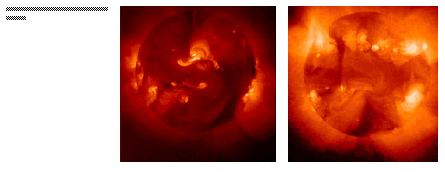
How does gravity come into play in the formation of the planets? The standard accepted theory of planet formations assumes the gravity as the main arbitrator. However, the theory of planet formation is intimately tied to the theory of star formation. In the conventional view, after the star has been accreted by gravitational pull and the magnetic force, and become hot enough to expel most of the surrounding gases, while creating a cavity in the molecular cloud, it is left with some material in the form of a disk around its equator. The disk then radiates away its energy and cools off. With the cooling, the metals, rocks and ice condense and form dust of tiny particles. These tiny grains collide with each others and forms objects of the sizes of the scales of the small asteroids. Once the size of these objects get bigger their capacity to attract grains by gravitational force helps them to grow at an accelerated pace,. By this process protoplanets are formed. The protoplanets, which are large enough, due to their gravity will pull the nebular gas and form giant gas planets. The smaller protoplanets will be rocky, or icy bodies. Eventually the rocky and icy protoplanets may collide with each other and break or merge to form bigger planets. This is how our solar system, containing inner rocky planets and the outer gas giants, is believed to have come into existence.
This model has many problems. The main problem is to explain how do the dust grains can stick together to form the planetesimal of kilometer sizes, which can have enough gravitational pull to accrete material and create the planets. Once the grains grow to the sizes of centimeters and meters, the collisions between the grains are more likely to break them, than coalescing them together. In fact, rocky cores of several Earth masses must form before giant planets like Jupiter and Saturn can come to existence. And this must happen within a short time before the material in the disk dissipates due to accretion as well as evaporation due to strong heat. The stellar wind will also sweep much of the disk gas. The gravitational encounter with other stars nearby will cause stripping of gas as well. In this so-called core-accretion model the formation of giant planets will take many millions of years. However, the material from which such planets may form can not survive as a disk around the young hot stars for such a long time. The planet formation needs to proceed much quicker, within the life time of such disks.
The realization of the need for a new theory to explain how the planets my have been formed have increased with observations of the extra-solar planets, first discovered in 1995. Within the last 11 years since the first discovery the number of exoplanets have increased to about 200. It is now believed that at least 10% of the stars, which are similar to our sun, should possess planets around them. The real number can be much higher than this.
The first discoveries of extra solar planets were made by observing the shifts of the spectral lines from the stars. These shifts, caused by the motions of the stars from and away from us, indicate that the stars are wobbling in periodic orbits. Such wobbles can be caused if a planet rotates around the star. The existence of most of the extra-solar planets, or exoplanets as they are called, are inferred mainly by means of such Doppler shift method.
For a handful of cases the existence of the planets have been inferred by the method of transit. It has been observed that flux of light from the star drops for a few hours at regular intervals of several days. It is believed that this reduction in flux is being caused by the shadows cast by the planets moving in orbits around the star. While a planet is crossing a star it is blocking some light towards the observer.
Only in April 2005, the claims about the direct observation of the "first" planets outside the solar system have been made by two groups. The planet named 2M1207b was first observed in September 2004, but was not confirmed before April 2005. A few days before that announcement of observation of another planet called GQ Lupi b was made. In fact, what these people observed were small planet-looking objects bound with the stars. However, no orbital motions were seen.
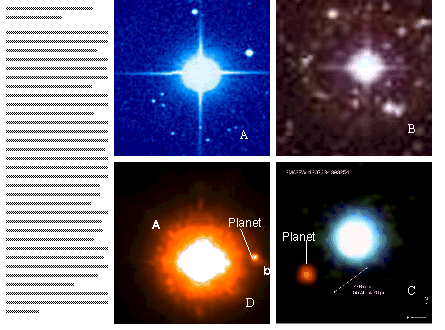
The discoveries of the exoplanets have brought the observational facts that the Jupiter sized planets can form very close to sun-like stars. They are called hot Jupiters. The conventional theory face great difficulties in explaining these exoplanet formations. Recently, a model based on idea of the formation of the planets from the breakdown of unstable circumstellar disks have appeared as the competitor against the conventional theory. In such model gravitational instabilities in the disk, formed around the star, will cause rapid fragmentation of the disks into smaller clumps within a time period of only a few thousands of years. From such clumps the planets will be born.
The other objects which bring challenges to the theorists are the existence of the so-called free-floating planets. They exist without being bound to any star. These free-floating objects are not understood. Some of them have sizes of tens of times bigger than the size of Jupiter, while some could be as tiny as a few percent of the mass of Jupiter. They are known as brown dwarfs, which do not burn as stars, while at the same time are not bound to stars as the planets are. The recent studies indicate that many of the brown dwarfs may have been formed in the same way the stars have formed.
My analysis indicate that the planet formation and the star formation could be intimately connected. The so-called free-floating planets, or brown-dwarfs, could be the objects ejected from the clumps which ultimately turn into stars. As the stars form out of the turbulent eddies at the core, chunks of the gaseous material may break away. These clumps then follow the ejection paths governed by the magnetic field around the stars. Many such chunks will fly towards the regions where the bubbles form. These clumps at the end will form a halo of small bodies surrounding the stars, like the objects in the Oort's clouds around the sun.
The similar ejections may occur in the equatorial plane. Those objects, which have not been able to escape the star before the gravitational force exerted by the star has become the dominating source in affecting the dynamics of the bodies in the immediate surroundings (overwhelming the effects of the turbulence and the magnetic field), will turn into planets. According to this view the planets, the brown-dwarfs, and the stars take birth from the same process.
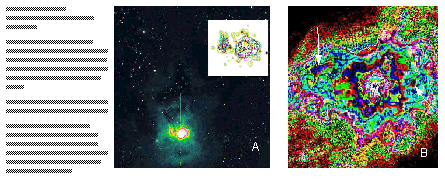
Thus I propose the view of the formation of the planets from the chunks fragmented from the material from which the star take shape. In this model the planets will form in a chaotic environment, where magnetic fields and eddies reign over the dynamics which may cause the fragmented chunks, evolving into planets, to migrate away from the stars. Those chunks which fail to attain the escape velocity of the gravitating stars remain bound around the stars as ring material. After the chaos has passed, the stellar wind has cleared away the surrounding, and the gravitation starts reigning over the other forces, the world around the star will become a quieter place, where objects may move in the Keplerian orbits, as observed in the solar system.
The rings which may form around the stars are very similar to what I have discussed in connection with the structure formations in the large scale. They may appear with the same universal characteristic as in the evolved galaxies, where such rings can be seen inside their cores. At the heart of the cores one can observe the 3D "spiral-knot" flanked by double lobed structures. As said, in my view, the planets are those structures which are created together with the evolution of the stars from vortices to compact 3D knots, which remains embedded in the 3D spiral structures. As the stars evolve the bigger chunks break away from the outer rings caused by gravitational instabilities, and turn into gaseous giant planets, while the smaller structures are blown out from the inner rings, where it is hotter. These planets contain heavier metallic elements. Naturally the planets closer to the stars are denser, smaller, hotter and enriched in metals.
It is newly being realized that the vortices form in proto-planetary disks around the stars. These vortices are very efficient in collecting the heavy particles in their cores, where the particles may efficiently coalesce. The vortices are seen to be the best places where the seeds of the planets may form. During the last few years it is becoming more and more clear
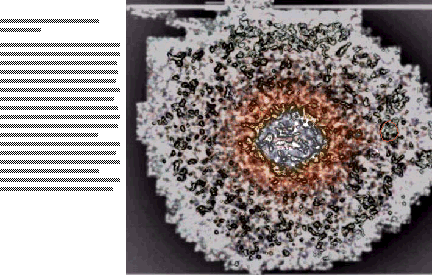
that vortex model of the formation of the planets could be the answer to resolve much of the problems, which the conventional models face.
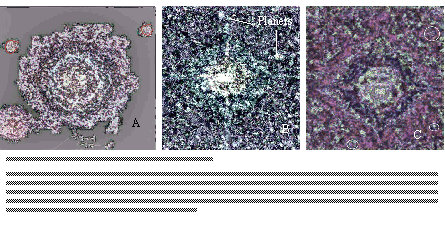
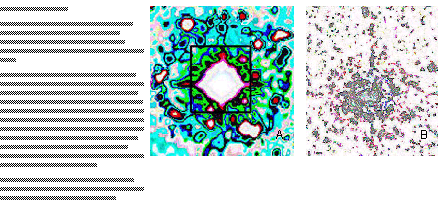
My analysis show that the planets may form from the fragmented pieces of the gas clouds where a star is under the process of evolution. The role of gravity may not be so important as the conventional theories assume it to be. The turbulent environment, where magnetic forces may trap eddies, may generate the cores large enough which will be able to gravitationally pull dusts and gases, while turning them into planets. However, these planets will not form in a disk wrapped around the equator of the star only. Those, which will form from the fragments ejected at the higher altitudes, will migrate into space as brown dwarfs, or so-called free-floating planets. The objects, which will form in the disk wrapping around the equatorial region, may also undergo migration due to magnetic and gravitational interactions among the bodies themselves, as well as the interactions of the planets and the discs. At the end this chaos will settle down into a calmer world, where the planets, which have not been already ejected out of the system by then, will settle into Keplerian orbits pulled by the gravitational force of the star. The objects, which we define as planets, could be only a small left over from a larger number of planet-like objects which form in the process of the star formation.
The best place to study the planets in such a calmer environment is the planetary system around the sun. Though the planets move in orbits in a near perfect accuracy powered by the gravitational force, the data sent by different spacecrafts like Voyagers, Pioneer, Ulysses, Galileo, Soho etc. during the last few years have changed our old ideas about the solar system. The data show that the planets are moving through a hazardous turbulent environment swirling around the sun. The pictures taken by SOHO show the constant outflows of the plasma wind from the solar corona, which are moving through the solar system extending beyond the realm of Neptune and Pluto. These solar turmoil moves in accelerated speed reaching millions of kilometers an hour as they pass by the planets. The atmosphere around Earth shield us from the hazards of the solar wind. A magnetosphere, which surround the Earth covering the distance of hundred thousand of kilometers from Earth's surface, trap the charged ions of the solar wind. These charged particles can only leak around the North and the South Poles. When they leak they create fabulous scenes of Auroras. Magnetosphere, similar to Earth, exists around the biggest planet in the solar system, Jupiter too, where the magnetic field is much stronger. On this planet one can observe much more fascinating Auroral activities than on Earth.
The wind blowing through the solar system has been found to give rise to a spiral magnetic field in the heliosphere. It is know as the Parker Spiral. The plasma blown from the sun creates a plasma sheet which varies in density in the interplanetary space and forms the spiral structure, similar to the two dimensional turbulence of swirling hurricanes. These winds are seen to interact with the atmosphere of the planets and the moons around the planets.
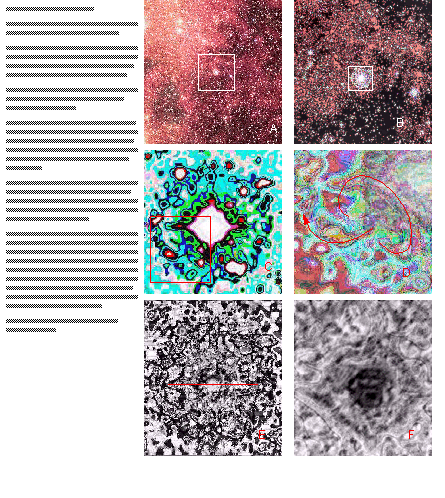
It is not fully clear what role the magnetic field caught in turbulence may be playing in our planetary world. The presence of turbulence is evident in all planetary atmospheres and the magnetic fields around the planets. We have now entered an age when man can take picture of the mother Earth from the surface of another planet.and study what may be happening around the home planet. It is possible to get an image of the winds and plasmas that strike the planet, and observe the shield which is protecting us from extinction. About a year ago in 2005 the Spirit Rover, which landed on the Gusev Crater on Mars, has sent the first picture of our planet ever seen from any other planet. By analyzing this picture it is possible to reveal a spiral structure around Earth. This structures spans along the Earth's magnetosphere. The Earth is securely protected at the womb of the spiral magnetic field.
The spiral structure appears in other planets too. Newly one has observed that F-ring of Saturn could be a spiral. The x-ray images taken of Jupiter by Chandra Satellite may also indicate the presence of spiral structure. The structure of Jupiter in x-ray is very similar to the spiral-knot structure seen in the centres of other cosmic objects at higher scales. In fact, the formation of the planets may have similarity with the formation of the stars. A flatter spinning core at the centre ejects material, which are lifted from the equatorial plane towards the polar regions. These elevated materials, as they move to higher altitudes, swing as a garden sprinkler, as the object rotates and form helically rising pattern. These helical arms may wrap around each other and create the structures seen in planetary atmosphere. The spiral appears in smaller satellites of the planets too. Pluto and its moon Charon could be examples of the formation of frozen 3D spiral structure. To what extent gravity plays an important role in governing the structure of the planetary atmosphere, compared to the roles played by turbulence and the electric and magnetic fields, remains to be understood. The electric phenomena observed in tornadoes tell us that the atmospheric dynamics in planets could be churned by electrical activities in the clouds. The helically moving spiral columns can be driven by electric forces. However it is very difficult to come to a full understanding of this question by doing simulations.
By observing some general features in the structures, which repeat at different scales in the cosmos, I have argued in this book that the structure formations proceed in the similar way at different scales in the universe. And this process involves mainly turbulence and the magnetic field, which in turn give birth to spiral structures - first as 2D spirals as seen in the spiral galaxies, and then into 3D spiral-form as the structures condense and evolve. As long as the dust concentration at the core, which at the end may generate solid bodies by coalescence, remain small the role of the gravitational force in structure formation may remain less significant.
As I have mentioned earlier, the success of the gravitational dynamics in the solar systems had been the main pillar in building the modern story of cosmic creation. The success of the theory of gravity in explaining the orbital motions had led us to make inferences about the entire cosmos by assuming that the gravity is the central player in creating the structures in the universe. With it the assumption of homogeneity and isotropy of the universe have been added as extra elements in building the gravity based theories.
The main argument of this book is that these assumptions may not be right. Instead I have proposed the view that everything in the universe could be caught in an eternal turmoil. This turmoil is carried by the spiral structures moving as eddies in different scales. These eddies are the foundation of structure formation in all cosmic scales. One should be able to observe these eddies and spirals starting from the scales of the planetary dusts, asteroids and planets to the largest structure one my observe. The spiral motions have been observed in comets and atmospheres of the planets. The dusts and gases which move around the planets may also form spiral forms. For example, the planet, like Saturn, could be entangled by spiral patterns woven together.
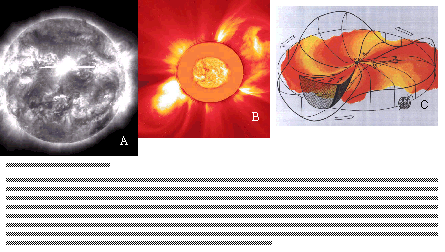
The ways the spirals wrap around the planets may differ from planets to planets. In the giant planets, like Saturn and Jupiter, the arms of these spirals are more tightly wound than, for example, the spiral around Earth. The spirals and the outflows observed from the planets could be dynamically related. The giant gas torus, which has recently been discovered around Jupiter, is caused by such outflows. The outflows, which originate in the planet may have bombarded the surface of its nearby moon Europa, which emits the torus material. Through this torus the Jovian moon Europa moves in orbit around the planet. The outflows from Saturn may be the source of dusts which replenish the rings, from which dusts may leak into space. While outflows occur, dusts and gases from the rings also interact with the atmosphere of the planet by the help of the magnetic fields. The ring material are levitated above the ring plane. These dusts move towards the planet at higher altitude and replenish the planet. Thus there may exist a balance between the inflow and outflow from the planet and the rings.
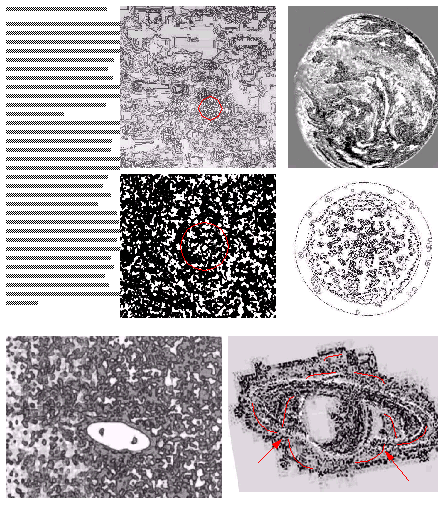
Pluto and Charon, which rotate as a rigid body system, also shows the presence of a spiral structure in this planet-satellite system. They rotate in the same plane as the spiral arms. In cases where Juipter-sized exoplanets have been observed close to the stars, they may be rotating like this Pluto-Charon system.The spiral structure may tell us how the so-called rings may form around the planets, or the stars. The outflows from the central body, governed by the magnetic field, as well as being acted upon by the pull of the gravity, create the rings, while the spiral arms wound around the central structure. These rings are connected by outflowing material forming spoke-like structures.
The Cassini Spacecraft have observed storms occurring in Jupiter, and collected data for a period of 72 days, while passing by the Jupiter on its way to Saturn. The movie created from the infrared data is a nice example to explain what might be happening as regards the formation of the atmosphere of the planet. These observations indicate that the storm persists unabated for the whole period of observation, and point to the dynamics which may be central as regards the dynamics of structure formation in the universe.

By analyzing the video one can see how an ever changing storm generates an unchanging pattern, which maintains its fractal characteristics as seen in the vortices. Bands of cyclic motions surround the central pattern, and form orbits along which smaller vortices move, in the same way as the planets move around the sun. The smaller vortices go around the centre, along the orbits, while the storm maintains a stable internal structure. These vortices, moving in counter rotating orbits, may maintain individual existence for a period of time. After a while they may merge with other eddies and grow bigger, or break up into smaller eddies, which disperse in the system by generating chaotic motions.
The central structure blows jets outward while it rotates. The motions of the rotating jets resemble the motions of particles blown from a sprinkler. They generate spiral arms, which swing around the sprinkler. Faster the rotation, and closer one approaches the sprinkler, one observes toroidal structures around the spinning body. The spiral arms bifurcate in order to join the arms which lie immediately inside, or outside it in a fractal build up. Thus successive rings, enveloping each other, may form. The magnetic fields, following the rotating spiral arms, twist together and pull material along the rotation axis towards the polar regions. The motions of the spiral plasma sheet around the sun could have been generated by a similar way. What one observes in the sun could be a scaled up version of a phenomenon, which one sees in the scale of Jupiter.
The formation of planets around the stars may follow such dynamics where the smaller vortices collect dusts and coalesce into solid cores, or, in another possibility, they may break up by scattering dusts and creating chaos. Once the solid cores are formed, the gravitational pull will help them to accrete more dusts and gas. Collisions and chaos may constantly change the orbital paths of such proto-planets, until the planetary orbits will become stable by forming resonant interactions. One may ask why the planets under formation do not fall towards the star? The reason could be the balance between the infall and the outflow. The eddies are constantly repelled by the ejecting outflows, and the centrifugal force, as well being pushed towards the core by the inflow due to angular momentum, magnetic accretion, and gravitational pull. The video from the Jovian storm may give a clearer understanding of how this infall and outflow may take place.
As mentioned before, the material in each ring in the storm system are replenished by the rings inside and outside it. The outflow from the inner belt, and inflow from the outer belt, replenish the material in the rings. While material is replenished in a ring by the immediately adjacent rings, in turn, the ring looses material by blowing material to the outer ring, as well as feeding the inner ring which it itself envelopes. Thus all rings sustain their existence as an interacting system, joined by bifurcation from one scale to the other. In every ring material there exists two ways push - one due to outflow and the other caused by inflow. In the Jovian storm one can study how the inflow and outflow may oscillate, while keeping the small vortices flying through the orbits.
In fact, such a storm system can generate the effects resembling a gravitating body. The material flowing inward from the outer belts resemble as if being acted upon by a gravitational force, while the material flowing out from the centre may simulate a counter acting repelling force. These two opposing dynamics make the objects move along fixed orbital paths.
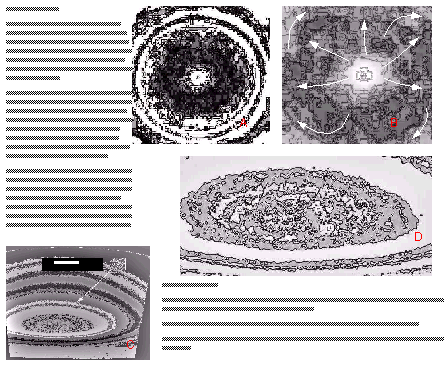
As in the case of the cosmic structure formation, in other scales in the universe, the Cosmic Design is woven at the core region, which, in turn, enwombs a 3D spiral knot at its heart. The Design may appear as magnetic spiral plasma sheet, which surrounds the core. Within this design both inflow and outflow occur, and the motions are not circular as in all turbulent structures. However, when such structure evolves from a 2D spiral form, the fractal design remains enwrapped inside a series of ring structures, which appear as bands of plasma and dust circulating around the central object. The motions of these bands carry with them the stable vortices which may have formed around the centre. The motions outside the core of the vortex, where the vorticities are still concentrated at the centre, the velocities increase from the centre to the boundary of the vortex wall. This wall defines the boundary of the core, and whirling becomes most intense at this boundary region.
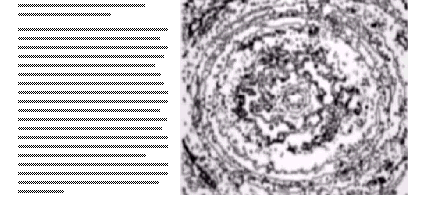
In my view, I repeat again, the cosmic structure formation is not driven by the gravitational force, but instead, driven by the vortex dynamics, which sets the twisting of the magnetic fields, which, in turn, generates the shapes of the cosmic objects as they evolve under the actions of the turbulent magnetic field. The energy in the universe is distributed in such a way that expulsions and accretions occur at the same time everywhere. The cosmic objects in all scales interact with each other while exchanging energies from one scale to the other. The purpose of this energy exchange is to sustain a cosmic perfection, which is revealed as the fractal geometric design. The universe consists of a network of flow paths, intertwined in the void, which appears in the same way in whatever scale one may observe the cosmos. All matter and energy are destined to follow these paths determined by the pattern seen in the multifractal design of the turbulence. In that sense the space i.e. the so-called vacuum, is the controller of all happenings in the universe. However, it is not the differentiable curved space-time, which Einstein has conceived. Instead, it is a non-differentiable fractal object, where matter and void can exist only in arrangements dictated by the pattern of the network. The answer about the nature of gravity should be sought in this fractal dynamic of nature of the universe.
In models of star formation, where turbulence has been accepted as the major dynamical player, the origin of turbulence, which sets the first premise of the formation of the pre-protostellar core, are difficult to explain. In most of these models the turbulence are believed to arise from the deaths and explosions of stars, as supernovae, occurring inside the molecular clouds. In the scenario of structure formation based on the vortex model, the turbulence seen in clouds of any size, where stars, or galaxies, or clusters, or supeclusters may form, are caused by the injection of energies from the higher scale, in which the smaller cloud structures remain embedded. The energy transfer occurs in cascading manner, which set the turbulent churning at different scales. The energies lost from on scale may, in turn, be replenished by feed back from smaller scales to the larger ones. The universe works through this energy cascade and feedback, as a self-regulated system, where all that flow out return as inflows after moving through an intricate maze of fractally knitted design.
Not only there exists magnetic field in the planets and stars, the galaxies and clusters of galaxies too are magnetized objects. The measurements of the magnetic fields in galaxies indicate a close relationship between the Cosmic Design and the magnetic fields. The magnetic nature of the galaxies has been unfolding with the observation of the continuum radio emissions, which arise from the interactions of the charged ions with the magnetic field through which they move. These are called synchrotron emissions. The bulk of the radio emission below 5 GHz from our galaxy is generated by the magnetic field in the galaxy. By studying the nature of polarization of the emitted radiation one may find out the properties of the galactic magnetic field. When polarized beam move in the direction of the magnetic field the plane of polarization rotates. It is known as Faraday rotation. By measuring the Faraday rotation one can gain knowledge of the magnetic field of the large scale cosmic structures. The magnetic field studies of the galaxies and clusters of galaxies clearly reveal the nature of turbulence in the large scales. The magnetic field seem to trace the Cosmic Design, which is the geometric foundation behind all turbulences including plasma. So, it seems that the magneto-hydrodynamic turbulence lie behind the formation of structures like galaxies, clusters and superclusters. The way the spiral galaxies evolve and turn into ellipticals, embossoming 3D-spiral knot structures at their cores, and bearing the properties of quasars, could be similar to the way the flat spiral structure in the pre-protostellar cores turn into 3D-stars driven by the dynamics of turbulence and the magnetic fields. It seems to me that the formation of the large scale structures can be explained without assuming that the gravitational forces play important roles. Thus if we turn to the view that universe exists as a vortex as an embodiment of an order through which the universe self-regulates all outflows as inflows in all scales, the gravity is not the force which decides over the creation of the structures in the universe. It plays only a minor role when the solid bodies of enough gravitating mass takes birth out of turbulence entangled in strong magnetic fields.
For more than hundred years there has been a speculation about the relationship between the magnetic field and the gravitational force. But none of these speculations has gained sufficient acceptance in the academic community. However, the experiments in microgravity where fluid flows have been studied inside a spherical capacitor, indicate interesting phenomena as regards this connection. In the Geophysical Fluid Flow Cell (GFFC) experiment conducted by NASA, electric field was applied across a spherical capacitor filled with a dielectric liquid. They could simulate the effect of gravity as seen in Earth's atmosphere. The high density liquid sank towards the central sphere with higher field strength and the warmer gas rose generating a spiral roll upward towards the outer sphere.
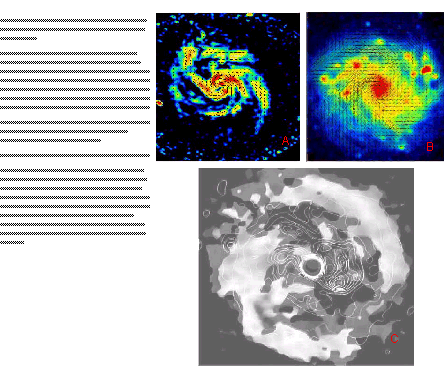
Interesting connections between gravity and magnetic fields also exist on the crust of Earth and Mars. The gravitational pull of the earth is not the same everywhere on the earth's crust. The measurements made at the pole, or the island on the specific, or in Asia, or in a place in Europe, or America give varied values of the gravitational strength. They are known as gravitational anomalies. Such anomalies have been mapped. The map of the gravitational anomalies shows that gravitation is stronger where the magnetic field strength is enhanced. They seem to follow the regions of active volcanoes on earth.
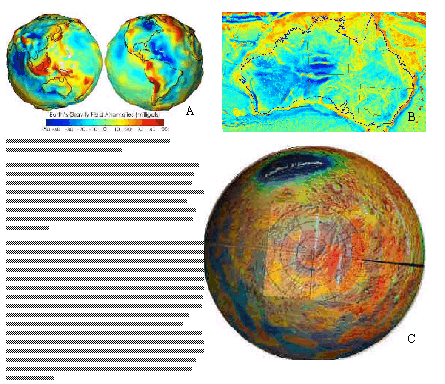
A similar connection also exists as regards the gravitational anomaly and the crustal magnetic field on Mars. Apart from that, the solar eclipses have been observed to influence the geomagnetism. During such eclipses Fecault's pendulums have been found to behave erratically. Superconducting rings have been seen to generate gravitational effects too.